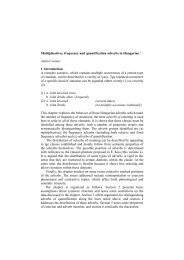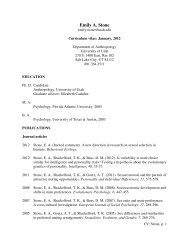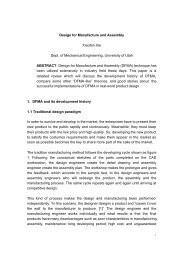DFMA as Applied to the Swingline 747 Desktop ... - University of Utah
DFMA as Applied to the Swingline 747 Desktop ... - University of Utah
DFMA as Applied to the Swingline 747 Desktop ... - University of Utah
You also want an ePaper? Increase the reach of your titles
YUMPU automatically turns print PDFs into web optimized ePapers that Google loves.
<strong>DFMA</strong> <strong>as</strong> <strong>Applied</strong> <strong>to</strong> <strong>the</strong> <strong>Swingline</strong> ® <strong>747</strong> Desk<strong>to</strong>p Stapler<br />
The <strong>to</strong>tal <strong>as</strong>sembly time can <strong>the</strong>refore be derived from Table 6 <strong>to</strong> be 108.86 seconds.<br />
2.6a Efficiency<br />
Using Nmin = 19 (two f<strong>as</strong>teners), ta = 3 seconds, and tma = 108.86 seconds from<br />
Table 6, <strong>the</strong> efficiency for <strong>as</strong>sembling t he stapler is <strong>the</strong>n 53%.<br />
2.6b Chamfers<br />
The insertion <strong>of</strong> <strong>the</strong> pin and <strong>the</strong> anvil actua<strong>to</strong>r are subjects for chamfer analysis.<br />
We present <strong>the</strong> analysis for <strong>the</strong> pin only. Table 7 gives <strong>the</strong> chamfer dimensions for <strong>the</strong><br />
pin.<br />
Table 7 – Insertion Parameters for <strong>the</strong> Pin<br />
There is no chamfer around <strong>the</strong> insertion point. The pin h<strong>as</strong> a rounded chamfer, <strong>the</strong>refore<br />
no angle or chamfer width is given. From <strong>the</strong>se data, we can calculate <strong>the</strong> clearance c<br />
between <strong>the</strong> pin and <strong>the</strong> b<strong>as</strong>e <strong>to</strong> be 0.016 in. Since <strong>the</strong> clearance is so small, <strong>the</strong> pin uses<br />
a rounded chamfer. The insertion time is 44.2 ms using ti = -70 ln c + f(chamfers) + 3.7L<br />
+ 0.75d where f(chamfers) is -250. Despite <strong>the</strong> fact that insertion in<strong>to</strong> <strong>the</strong> b<strong>as</strong>e, cover,<br />
and sub<strong>as</strong>semblies is progressive, we consider <strong>the</strong> diameters D <strong>to</strong> be <strong>the</strong> same and <strong>the</strong><br />
length L <strong>to</strong> be <strong>the</strong> entire width <strong>of</strong> <strong>the</strong> b<strong>as</strong>e along <strong>the</strong> insertion axis. As <strong>the</strong> pin is inserted<br />
and parts through which it travels added, <strong>the</strong> stability <strong>of</strong> <strong>the</strong> pin incre<strong>as</strong>es. There is also<br />
<strong>the</strong> draft on <strong>the</strong> b<strong>as</strong>e <strong>to</strong> consider. Since <strong>the</strong> clearance is such that <strong>the</strong> pin is inserted ra<strong>the</strong>r<br />
e<strong>as</strong>ily, <strong>the</strong> draft need not be a concern.<br />
2.7 Recommended Changes<br />
D 0.189<br />
d 0.186<br />
L 1.253<br />
w2<br />
θ2<br />
A few changes in <strong>the</strong> manufacturing process led directly <strong>to</strong> changes in <strong>as</strong>sembly.<br />
For instance, if <strong>the</strong> spring is halved and <strong>the</strong> upper staple guide is redesigned, <strong>the</strong> spring<br />
31<br />
0<br />
0





